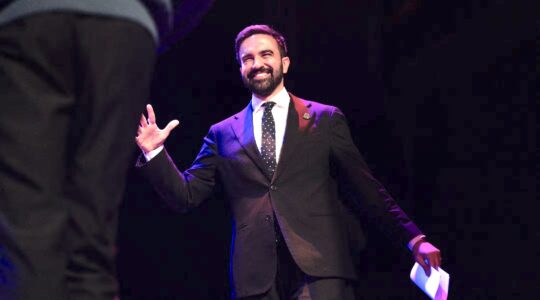When my father-in-law gave me and my husband Michael a birthday gift of sessions with his personal trainer, I realized that I had a choice: I could choose to be offended (as my mother-in-law was when he tried – and failed – to gift her a bathroom scale for her birthday) or I could choose to see this as an opportunity to get myself whipped into shape. Since I genuinely like my father-in-law, and he’s not known for beating around the bush, I chose the latter perspective. Michael and I booked our appointment with the trainer, Mona, and got ready to turn our flabs into abs. Little did I know that the muscle most in need of this workout was my ego.
By the middle of the first session, I knew that this was not turning out the way that I had pictured. I am a take-charge kind of person – I run my own business, I make all of our family’s social plans, and I like to achieve, accomplish, and yes, win. Even if there’s nothing to win – that’s irrelevant. But within 20 minutes of crunching, squatting and pushing-up with Michael and Mona, I was feeling like I wanted to lunge at them rather than with them. I was falling behind. I was barely keeping up. I could not compete.
As much as I wanted to curl up into a child’s pose (the only yoga move I’ve mastered because it requires little more than lying on the floor in a ball and breathing), I wasn’t permitted to. Mona made me get up and get moving. I wasn’t allowed to quit, but my spirit was being crushed as I squeaked out a set of “skull-crushers” with a 12 lb weight while balancing precipitously on a stability ball. Why was this so hard for me, I wondered – not about the workout, but about doing such a poor job. Why was I more miserable about falling behind that the size of my behind?
Because I wasn’t the leader. I had to follow. And when it comes to “going along with” rather than blazing the trail, my “followership skills” are out of condition as the rest of me.
What was I even thinking? I was working with a professional trainer who was being paid to lead me. I was also working alongside Michael, who competes in triathlons — for fun! There was no way that I was going to be the best, the strongest, the boss. Heck, I was lucky that I was able to be a part of this party. Nevertheless, learning to follow was going to be a bigger workout for my head, heart and soul than I had anticipated. And learning to follow might be a challenge for you, too.
We are bombarded with messages that tell us the who, what, where, how, why and when of leadership. My bookshelf is filled with tomes on leadership from gurus such as Jack Welch, Jim Collins, Susan Scott, Tom Peters, and many, many others. These books teach us how to step up, stand out, take charge and march ahead in a way that compels others to follow. And their messages about how to lead are indeed gripping.
Peter Drucker wrote, “Leadership is lifting a person’s vision to higher sights, the raising of a person’s performance to a higher standard, the building of a personality beyond its normal limitations." McDonald’s founder Ray Kroc contends, “The quality of a leader is reflected in the standards they set for themselves.” Author Rabbi Adin Steinsaltz writes, “A nation needs its guides and shepherds, its scouts and leaders of the flock who will carry out the function of leadership: the ability to feel and the power to think.” I get it – I do: It’s important to create and communicate a vision, raise the bar, be empathetic and engage in critical thinking. These competencies are at the heart of leadership.
But former Speaker of the House Sam Rayburn adds another skill set into the mix: "You cannot be a leader, and ask other people to follow you, unless you know how to follow, too." That’s a new perspective for many of us – whether we are in official positions of leadership, or struggle with the fact that we’re not. Either way, learning to step back and abide by someone else’s plan is part of leadership, and frankly, part of life. Admittedly, it’s a part of life that I struggle with – whether that person with a plan is my trainer, my boss, or my God.
And yes, even my husband. When Michael and I were planning our wedding, we decided to take dancing lessons at the 92nd Street Y in New York City. We stood in a room with a dozen other couples who didn’t know how much they’d wanted to learn to Samba until they’d put a four-figure deposit down on a band. As we listened to the instructor give us directions, Michael and I held one another and started to move with the music. But one thing continued to get in our way: I could not not lead.
Michael would point this out, lovingly at first, and then with increasing frustration over the next hours. I didn’t know how to dance any better than he did, but I was used to taking charge in anything and everything (you get one guess as to who signed us up for dance lessons in the first place). It took many hours, countless reminders, and ultimately, a realization that these dancing lessons were also life lessons for a marriage that I wanted to last. As Rashi reminds us, “Obeying from love is better than to obey from fear.” And while I might have been fearful about getting my foot stepped on from time to time, I was following out of love, respect and commitment. Over time, I was able to relax my leadership instincts enough to be led on the dance floor, and in life.
In his article, “The Ten Rules of Good Followership,” Colonel Phillip Meilinger of the United States Air Force contends that we all need to become better followers, because “all of us will be followers more often than we will be leaders.” Of course, if we’re going to be followers, we want to follow people whom we trust. But we also need to trust ourselves to know that operating under the direction and guidance of someone else doesn’t diminish our own leadership. It teaches us critical lessons about what a great leader can and should do.
The New York Jewish Week brings you the stories behind the headlines, keeping you connected to Jewish life in New York. Help sustain the reporting you trust by donating today.




